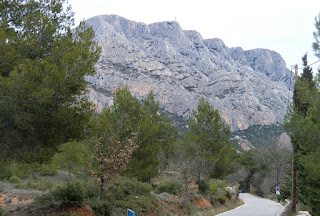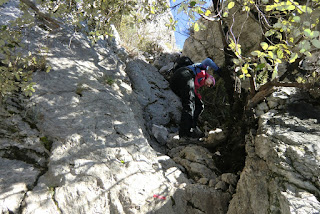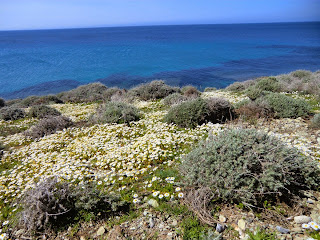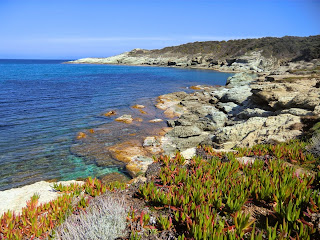Saint-Ser Vineyard and Montagne Sainte-Victoire
The massif of Sainte-Victoire comprises different plateaus between 400 and 1000m. It is about 8 km east
of Aix-en-Provence and dominates le pays d-Aix. It is famously known as Paul Cézanne’s favourite local subject and he must have painted it over fifty times.
The steep southern face of Mont Sainte-Victoire changes colour from grey to pink according to light and time of day. When driving from Aix-en-Provence east, take the D17 road (also Route Cézanne) which winds in the traditional Mediterranean countryside. We took this route in late March admiring the view of the mythic Sainte-Victoire immortalized in Cézanne’s paintings.
We drove as far as to Le Relais de Saint-Ser, where we had booked two nights. The hiking trail to chapel Saint-Ser (624 m) and Pic de Mouches (1011 m) goes right behind the parking of the hotel (400 m). This was one of the reasons why we booked here, the other being that this small auberge is known for its excellent restaurant. It was situated in the middle of the beautiful and quiet nature, the rooms were newly renovated and we were happy with the dinners.
The first day turned out to be rainy and cool, in spite of the favourable forecast a week or so earlier. We therefore explored the surroundings by car. Our first stop was the nearby vineyard Domaine de Saint-Ser. This is the highest situated vineyard of the almost thirty vineyards that have obtained the AOC Côtes de Provence Sainte-Victoire. After tasting, we opted for Cuvée Prestige Rouge 2010 (a blend of Grenache, Syrah and Cabernet Sauvignon) and purchased six bottles at 12,50 € each.
After the vineyard, we drove to Puyloubier, then along D10 past Vauvenargues to Aix-en-Provence. The northern face of Montagne Sainte-Victoire is less steep and the D10 road winds in a woody landscape.
The next day we woke to blue sky and warm sunshine. From the parking of our hotel at 400 m, we started following a good path marked with red signs. After just about 40 minutes we reached the chapel of Saint-Ser restored in 2001. Every May the pilgrimage of Saint-Ser honours the memory of the hermit Servius who was said to be living in the small cave nearby. From the chapel, you already have a superb view down to the valley.
It had been an easy walk up to the chapel, but after this the ascent became steep. After some scrambling we arrived at a truly steep part. As we did not have any climbing experience, we did not wish to take any further risks in spite of a chain that was permanently attached to the rocky wall. So we descended back.
In spite of this, we enjoyed the great views and the sunny spring day!





























0 comments:
Note: only a member of this blog may post a comment.